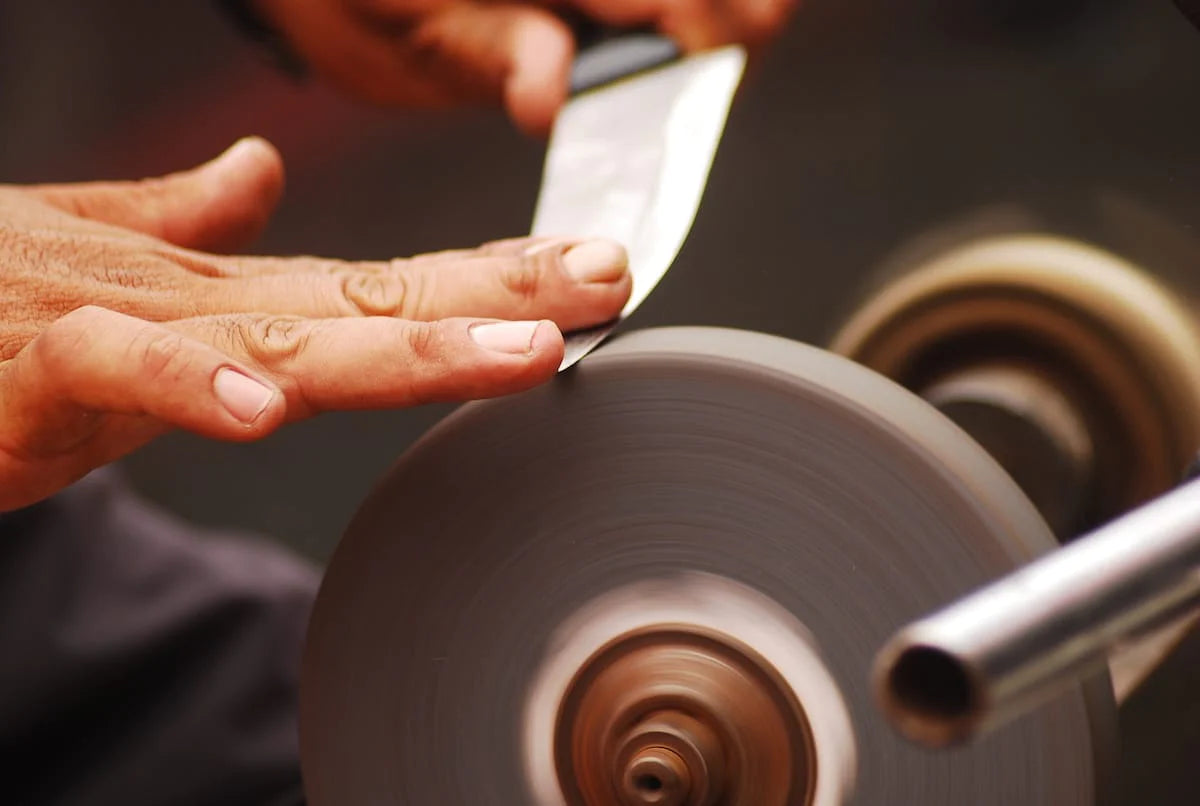on all orders over $100

Sharpening vs. Honing: What's the Difference and Why It Matters
Keeping your tools sharp is an essential aspect of any DIY or professional trade. Whether you're a woodworker or a chef, a sharp tool is always more effective and efficient than a dull one. But when it comes to sharpening, many people confuse it with honing, and some even use the terms interchangeably. So, what exactly is the difference between sharpening and honing, and why is it important to know?
The Basics of Sharpening
Sharpening, in broad terms, refers to the process of removing material from the edge of a tool or blade to create a new edge or restore an old one. This process is usually accomplished with an abrasive material like a sharpening stone, waterstone, or diamond plate. The goal of sharpening is to create a V-shaped edge that tapers from the spine of the blade down to the cutting edge, which is as sharp as possible.
When it comes to sharpening, there are different methods and materials you can use depending on the tool you're working with. For instance, a chef's knife should be sharpened at an angle of between 15 and 20 degrees, while a chisel should be sharpened at a shallower angle of around 25 degrees. Additionally, the coarseness of the abrasive material you choose will depend mainly on how dull the tool is to begin with.
The Importance of Sharpening
Why is it so important to sharpen your tools, you might ask? The main reason for that is that a sharp tool will always perform better than a dull one. A sharp tool cuts through materials more efficiently, which means you'll spend less time and physical effort getting your work done. Additionally, a sharp tool is often safer to use than a dull one, as a dull blade can slip and cause accidents.
The Basics of Honing
While sharpening refers to the process of removing material from a blade to create a new edge or restore an old one, honing, on the other hand, refers to the process of refining and maintaining an existing sharp edge. Honing does not involve removing any material from the blade, but rather using a honing steel or strop to straighten and reposition the edge, making the blade sharper.
A honing steel, for instance, is a long, narrow rod made of steel or ceramic that is used to straighten the edge of a blade. The blade is placed at an angle against the honing steel and drawn across it, honing the blade. A strop, on the other hand, is a strip of leather or a similar material that is used to polish the edge of a blade. The blade is pulled at an angle across the strop, which aligns the edge of the blade and makes it sharper.
The Importance of Honing
One important aspect of honing is that it can significantly extend the life of tools between sharpening sessions. A honing steel is an inexpensive tool that can be used daily to realign the edge of a knife or chisel, keeping it sharper for longer. Honing can also be useful for maintaining the sharpness of tools that are frequently used, such as woodworking chisels, without having to sharpen them every time they're used.
Sharpening vs. Honing: What's the Difference?
So now that we know what sharpening and honing are, what's the difference between them? While the two terms are often used interchangeably, there are fundamental differences:
- Sharpening is about removing material from the blade to create a new or restored edge, while honing is about refining and maintaining an existing edge without removing material.
- Sharpening requires an abrasive material like a sharpening stone or honing guide, while honing usually involves a honing steel or strop.
- Sharpening is something that will need to be done periodically to bring the tool back to a good working condition, while honing can be done regularly to keep the edge sharp after sharpening.
Why It Matters
Knowing the difference between sharpening and honing matters because it can help you optimize your tool maintenance to get the best possible results. By understanding when to sharpen and when to hone, you can use your tools more effectively and extend their lifespan. Additionally, by honing the blade regularly, you can maintain maximum sharpness for longer periods, without having to spend time sharpening every time you've used it.
Final Thoughts
Sharpening and honing are two essential aspects of maintaining the sharpness of your blades and tools. While the two terms are often used interchangeably, sharpening involves removing material from the blade to create a new edge or restore an old one, while honing involves refining and maintaining an existing edge. By understanding the difference between the two and knowing when to use each method, you'll be able to keep your tools in excellent working condition, cutting through materials with precision and ease. Sharpening and honing can also help you work more safely, reducing the risk of accidents that can occur when working with dull blades.
When it comes to sharpening and honing, there are different methods and materials to use depending on the type of tool you're working with. Learning the proper methods and techniques for each tool can take some time, but the results are well worth it. By regularly maintaining your tools, you can prolong their lifespan, save time, and keep your work at the highest level of quality.
In conclusion, knowing the difference between sharpening and honing is crucial for any DIY or professional tradesperson, whether you're a carpenter, mechanic, chef, or artist. By understanding the basics of each process, you can maintain the sharpness of your blades and tools for longer periods, work more effectively and safely, and achieve the best possible results. With a little practice and the right tools, you can master the art of maintaining your tools, ensuring that they're always ready to get the job done.
